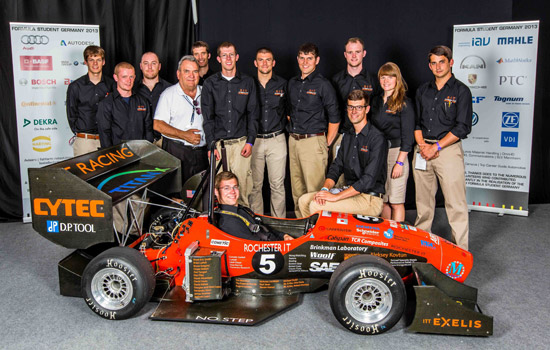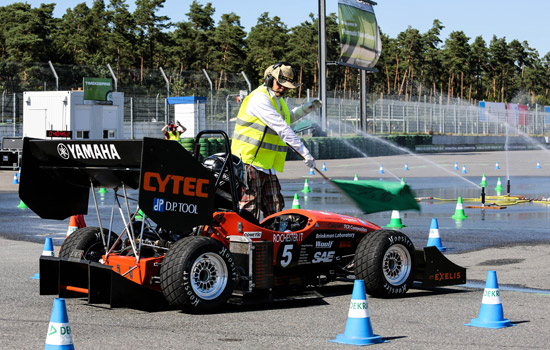RIT Formula car recognized for design
Team completes racing season with solid placements in Michigan and Germany competitions
Provided by Formula Student Germany
Kevin Ferraro takes the green flag for the autocross event, one of the dynamic events in the overall SAE Formula competition held Aug. 2-5 in Germany. RIT Formula Racing placed 39th overall among the 75 international collegiate teams competing.
Only a fraction of a Formula Racing competition is driving.
“When you look at an overall competition, it seems like it’s just minutes spent actually driving the car, compared to the hours spent on preparation, design, testing and validating design decisions,” says Travis Newberry, RIT Formula Racing’s team project manager.
That preparation paid off for the RIT team that just completed a successful competition season at its two events in Michigan in May and in Germany this month. The team received top placements in individual events and was recognized for its lightweight car design, winning the Audi Ultra Light Design Award at Formula Student Germany.
Competitions involve both static events—presentations about the car’s design, cost details and integration of technologies—as well as dynamic events such as acceleration, skid pad and endurance. RIT Racing placed second in the business plan presentation, fourth in the engineering design category and took a top-20 placement in autocross, placing 39th overall among the 75 international collegiate race teams competing in Germany.
Challenges with its turbo-charger system resulted in the team being unable to complete the endurance event in the competitions, a major portion of the score. Despite the problems, Newberry remains confident that the decision to use the turbo application is sound, and that further testing—and more experience—will provide a competitive advantage.
“It was something the team had not done before, but we’ll solve the issues,” he says. “We want to optimize the system we have, to make sure we get the most out of it, rather than jump ship and try something else.”
The team installed a modified Garrett GT0632SZ turbocharger system. The GT06 is the only turbo that will operate above the surge line for this application and is the smallest turbocharger that Garrett makes, says Chris Batorski, lead powertrain engineer and a mechanical engineering student. “The stock flanges are cut off and new custom flanges are welded on, making the turbo housing smaller and lighter,” he adds. This system was chosen over a naturally-aspirated system, commonly referred to as an internal combustion engine system, because it is capable of producing more power and torque, especially at lower rotations-per-minute.
“The turbocharged system is more complex and does weigh more than its naturally-aspirated counterpart, but the benefits will far outweigh the costs once the complications are resolved,” Batorski says.
Learning more about the system and its impact on the racecar will be done this year with a younger team, as five experienced members graduated in May. Newberry, a mechanical engineering major in RIT’s Kate Gleason College of Engineering, is one of a few upper-class students remaining who will mentor returning second- and third-year engineering students. A Rochester resident, Newberry transferred to RIT from Genesee Community College and has been on the Formula team since his arrival three years ago. This past year, he was electronic design engineer before moving up to the leadership role. The support the team gets from RIT is invaluable and an advantage that other teams do not have, he says.
“You can see the knowledge you gain from making the parts for the car yourself,” he says, adding that the team’s access to the machine shops and Brinkman Lab in the engineering college to build the majority of the parts that go into building the racecar gives them an edge. “You don’t really know something until you’ve done it. You solve the problem, see the results that you have control over and you can relate that back to classes. That’s something you gain on top of everything else.”
Note: RIT Formula Racing was featured in a case study-article by Seimens Corp. about it use of the company’s Femap simulation system. The team will compete in the Toronto Shoot Out on Oct. 19 and participate at the RIT Brick City Homecoming & Family Weekend.
 The 2013 RIT Formula Race team was recognized for its outstanding, lightweight car design at the recent SAE Formula Student Germany competition in August. Standing left to right: Nicholas Ryan, Kevin Ferraro, Travis Newberry, Alan Nye (mechanical engineering professor and team adviser), Sal Fava, Phil Vars, Aaron League, Tim Moran, Kyle Abbott, Tyler Peterson, Jaclyn Pytlarz, Kevin Albino and, seated in car, Brian Guenther. Provided by Formula Student Germany
The 2013 RIT Formula Race team was recognized for its outstanding, lightweight car design at the recent SAE Formula Student Germany competition in August. Standing left to right: Nicholas Ryan, Kevin Ferraro, Travis Newberry, Alan Nye (mechanical engineering professor and team adviser), Sal Fava, Phil Vars, Aaron League, Tim Moran, Kyle Abbott, Tyler Peterson, Jaclyn Pytlarz, Kevin Albino and, seated in car, Brian Guenther. Provided by Formula Student Germany













